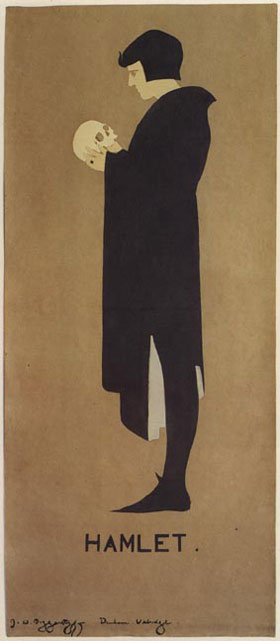1A
W.S. HARDY’S COMPANY. | HAMLET.
1A [Commercial poster for W.C. Hardy's production of Hamlet, London, 1894]
Four-color stencil and hand-painting on grey-brown wrapping paper: pale grey, buff, brown and black. Denham: William Nicholson and James Pryde (The Beggarstaff Brothers), published Aug 1894. Signed lower left: J. W. Beggarstaff. Denham Uxbridge. 29 7/8" w. x 70 7/8" h. (76cm w. x 180cm h.)
The actor Edward Gordon Craig,
who portrayed the title role in Hamlet for W.S. Hardy Shakespeare Company, commissioned this advertising poster from Pryde and Nicholson.
Craig was the son of stage actor Ellen Terry, and rented a cottage from her, neighboring that of Pryde and Nicholson’s. In addition to acting,
Craig was an accomplished artist and theatrical designer. He became interested in printmaking, and his style is very similar to that of
Nicholson’s.
This first poster is signed with the pseudonym ‘Beggarstaffs.’ It is possible that they did not want their excursion into commercial art to prejudice
their careers as painters in any way, but there is no concrete evidence that they wished to conceal their real identities, and they seem
simply to have regarded a single pseudonym as a conveniently brief alternative to their own two names, and an appropriate symbol of the
idea that their work was the product of equal endeavor.
When the anonymous reporter from The Idler asked the artists a year or two later how they came to choose the soubriquet “Beggarstaff,”
Nicholson explained that “Pryde and I came across it one day in an old stable, on a sack of fodder. It is a good, hearty, old English name,
and it appealed to us; so we adopted it immediately.”
Pryde’s later version of how the name was discovered varies slightly from Nicholson’s, (Pryde believed that it was he alone who had discovered
the name and suggested its use), but his account is substantially the same.
Initially Pryde and Nicholson signed themselves J & W. Beggarstaff, and in due course this led a number of their admirers to refer to them as the
Beggarstaff brothers. However, the artists themselves, although brothers-in-law, hardly ever employed this description, and Nicholson in
particular protested against the use of the word brothers.
Ref: Bella-1 6, Brinckmann 130, Reims 1353, Sponsel p. 167, Spielmann 268, Hillier p. 109, DFP 13, Campbell 1A.
Collections: Graphics and Posters, Museum für Kunst und Gewerbe, Hamburg, Germany.
1a
HAMLET.
1a [Comp for Hamlet poster (1A), 1894] Four-color, hand-cut paper, and hand-painting on wrapping paper: pale grey, buff, brown and black. Uxbridge: William Nicholson and James Pryde (The Beggarstaff Brothers), 1894. Unsigned. 28 7/8" w. x 67 3/8" h. (73,4cm w. x 171,2cm h.)
The original comprehensive presentation sketch (also known as a “comp” in advertising & design), was created by Nicholson and Pryde at their studio, Eight Bells in Uxbridge. A bold, silhouetted image of simple colored paper, cut out and glued to a large roll of craft wrapping paper, this poster design was unlike any of its contemporaries. The artists thought it would stand out from the clutter of busy post-Victorian designs so popular at the time.
Ref: The original is untraced, but reproduced in Magazine of Art (Jan 1895) p. 117, La Plume (1 Oct 1895) p. 427, Hiatt p. 239, Hiatt-2 p. 50, Campbell 1a.
1B
HAMLET .
1B [Retail collector's poster advertising Hamlet, 1894] Profile of Hamlet, played by Gordon Craig, contemplating the skull of poor Yorick. Four-color stencil and hand-painting on grey-brown wrapping paper: pale grey, buff, brown and black. Denham: William Nicholson and James Pryde (The Beggarstaff Brothers), published Aug 1894. Signed lower left: “J. W. Beggarstaff. Denham Uxbridge.” 15 3/4" w. x 28 3/8" h. (40cm w. x 72cm h.)
Retail collector's version, a variation of Hamlet poster (1A), with no headline type at top. This stenciled poster was exhibited for the first time in a poster Exhibition at the Royal Aquarium in London, 1895. Organized by poster collectors and printers Edward Bella and G. de Malherbe, posters — and unpublished designs — were offered for sale. Accordingly, the Beggarstaffs entered four speculative designs (none of which presumably sold). Copies of their Hamlet poster were sold at 5 shillings each.
1B.1
HAMLET.
1B.1 [Color lithographic reproduction, f.a. Hamlet poster (1B)]. Four-color lithograph: pale grey, buff, brown and black. William Nicholson and James Pryde (The Beggarstaff Brothers). Printed by Imprimerie Chaix, Paris, 1898. Signed in image lower left: ‘J. W. Beggarstaff Denham Uxbridge’. Image: ?" w. x ?" h. Sheet: 11 3/8" w. x 15 3/4" h. (29cm w. x 40cm h.)
Les Maîtres de l’Affiche (“The Masters of the Poster”) series were originally issued in monthly installments by Imprimerie Chaix, the lithographic studio of Jules Cheret, from 1895-1900. Small reproductions of popular posters were offered in a more manageble — and affordable — standardized format for collectors. Subscribers received four prints a month, for a subscription price of about $3.00 a year. According to Campbell, the Maîtres prints were reproduced from an original one-sheet version measuring 29 1/2"h. by 71"h. Six of the Beggarstaff’s posters were reproduced in Maîtres: Harpers (Mar 1896), Don Quixote (Mar 1897), Hamlet (Feb 1898), Rowntree’s Elect Cocoa (May 1899), A Trip to Chinatown (Sep 1899), and Kassama Corn Flour (Sep 1900).
Les Maîtres de l’Affiche, issue 27, plate 107 (Paris: Imprimerie Chaix, Feb 1898).



